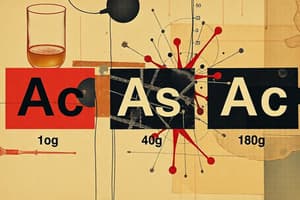Podcast
Questions and Answers
What is the smallest unit of an element that can enter into a chemical reaction?
What is the smallest unit of an element that can enter into a chemical reaction?
atom
Which of the following sub-atomic particles has a positive charge?
Which of the following sub-atomic particles has a positive charge?
- Neutron
- Electron
- Proton (correct)
- None of the above
Is the mass number equal to the number of protons plus the number of neutrons?
Is the mass number equal to the number of protons plus the number of neutrons?
True (A)
According to Dalton’s Atomic Theory, all atoms of a given element are ______.
According to Dalton’s Atomic Theory, all atoms of a given element are ______.
What is the law of conservation of mass?
What is the law of conservation of mass?
What describes the Main Electron Shell in quantum mechanics?
What describes the Main Electron Shell in quantum mechanics?
Match the following scientists with their contributions to atomic theory:
Match the following scientists with their contributions to atomic theory:
Is an isotope defined as having the same number of protons but a different number of neutrons?
Is an isotope defined as having the same number of protons but a different number of neutrons?
Study Notes
Atomic Theory Overview
- Democritus proposed the concept of "atomos" as indivisible particles.
- Aristotle rejected atomic theory; believed matter was continuous rather than composed of discrete units.
- Dalton's atomic theory revolutionized understanding by introducing key principles about atoms.
Dalton’s Atomic Theory
- Matter consists of indivisible particles called atoms.
- Atoms of the same element are identical in mass and properties.
- Atoms combine in simple whole-number ratios to form compounds.
- Chemical reactions rearrange atoms; no atom is created or destroyed.
Proust’s Theories
- Law of Definite Proportions: A given compound always contains the same elements in the same mass proportion, regardless of sample origin.
- Law of Multiple Proportions: When two elements form multiple compounds, the masses of one element that combine with a fixed mass of another are in ratios of small whole numbers.
- Law of Conservation of Mass: Matter cannot be created or destroyed in chemical reactions.
Atomic Structure
- Atoms: Basic building blocks of matter and smallest unit of an element that participates in chemical reactions.
- Different models of the atom:
- Democritus: "Atomos"
- Dalton: "Billiard Ball Model"
- Thomson: "Raisin Bread Model" (discovered the electron)
- Rutherford: "Gold Foil Experiment" (discovered the proton)
- Chadwick: Identified the neutron
- Bohr: "Planetary Model" for electron distribution
- Schrödinger: "Quantum Mechanical Model" representing electrons in 3D space.
Atom and Sub-atomic Particles
- Atoms are the basic unit of matter; Greek for "indivisible" is "atomos".
- Sub-atomic particles:
- Proton: Positively charged; found in the nucleus.
- Neutron: No charge; found in the nucleus.
- Electron: Negatively charged; 1/1836 the mass of a proton; negligible weight.
Atomic Symbols and Numbers
- Atomic number (Z): Equals the number of protons and electrons in a neutral atom.
- Mass number: Sum of protons and neutrons; calculated as atomic number + number of neutrons.
Isotopes, Isotones, and Isobars
- Isotopes: Atoms of the same element with the same number of protons but different numbers of neutrons.
- Isotones: Atoms with the same number of neutrons but different numbers of protons.
- Isobars: Atoms with the same mass number but different numbers of protons and neutrons.
Quantum Numbers
- Principal Quantum Number (n): Indicates the main electron shell and size of the electron cloud; values are positive integers (1, 2, 3...).
- Angular Quantum Number (l): Describes subshells and shapes of the electron cloud; values range from 0 to n-1.
- Magnetic Quantum Number (m): Describes the orientation of orbitals in space; values range from -l to +l.
- Spin Quantum Number (s): Indicates the spin of an electron; values are +1/2 or -1/2.
Rules for Quantum Numbers
- Three quantum numbers (n, l, m) define the allowed combinations for electrons in atomic orbitals.
Studying That Suits You
Use AI to generate personalized quizzes and flashcards to suit your learning preferences.
Related Documents
Description
This quiz explores the fundamental concepts of atoms, elements, and compounds. It covers key historical figures in atomic theory, including Democritus, Aristotle, and Dalton, and their contributions to our understanding of atomic structure. Ideal for students in the pharmacy program at Dr. Jose G. Tamayo Medical University.




